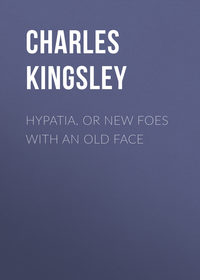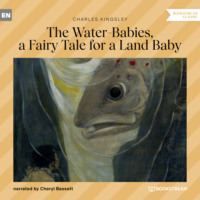 полная версия
полная версияAt Last: A Christmas in the West Indies
At last we stopped for breakfast. The horses were tethered to a tree, the food got out, and we sat down on a pebbly beach after a bathe in a deep pool, so clear that it looked but four feet deep, though the bathers soon found it to be eight and more. A few dark logs, as usual, were lodged at the bottom, looking suspiciously like alligators or boa-constrictors. The alligator, however, does not come up the mountain streams; and the boa-constrictors are rare, save on the east coast: but it is as well, ere you jump into a pool, to look whether there be not a snake in it, of any length from three to twenty feet.
Over the pool rose a rock, carrying a mass of vegetation, to be seen, doubtless, in every such spot in the island, but of a richness and variety beyond description. Nearest to the water the primeval garden began with ferns and creeping Selaginella. Next, of course, the common Arum, 178 with snow-white spathe and spadix, mingled with the larger leaves of Balisier, wild Tania, and Seguine, some of the latter upborne on crooked fleshy stalks as thick as a man’s leg, and six feet high. Above them was a tangle of twenty different bushes, with leaves of every shape; above them again, the arching shoots of a bamboo clump, forty feet high, threw a deep shade over pool and rock and herbage; while above it again enormous timber trees were packed, one behind the other, up the steep mountain-side. On the more level ground were the usual weeds; Ipomœas with white and purple flowers, Bignonias, Echites, and Allamandas, with yellow ones, scrambled and tumbled everywhere; and, if not just there, then often enough elsewhere, might be seen a single Aristolochia scrambling up a low tree, from which hung, amid round leaves, huge flowers shaped like a great helmet with a ladle at the lower lip, a foot or more across, of purplish colour, spotted like a toad, and about as fragrant as a dead dog.
But the plants which would strike a botanist most, I think, the first time he found himself on a tropic burn-side, are the peppers, groves of tall herbs some ten feet high or more, utterly unlike any European plants I have ever seen. Some 179 have round leaves, peltate, that is, with the footstalk springing from inside the circumference, like a one-sided umbrella. They catch the eye at once, from the great size of their leaves, each a full foot across; but they are hardly as odd and foreign-looking as the more abundant forms of peppers, 180 usually so soft and green that they look as if you might make them into salad, stalks and all, yet with a quaint stiffness and primness, given by the regular jointing of their knotted stalks, and the regular tiling of their pointed, drooping, strong-nerved leaves, which are usually, to add to the odd look of the plant, all crooked, one side of the base (and that in each species always the same side) being much larger than the other, so that the whole head of the bush seems to have got a twist from right to left, or left to right. Nothing can look more unlike than they to the climbing true peppers, or even to the creeping pepper-weeds, which abound in all waste land. But their rat-tails of small green flowers prove them to be peppers nevertheless.
On we went, upward ever, past Cacao and Bois Immortelle orchards, and comfortable settlers’ hamlets; and now and then through a strip of virgin forest, in which we began to see, for the first time, though not for the last, that ‘resplendent Calycophyllum’ as Dr. Krueger calls it, Chaconia as it is commonly called here, after poor Alonzo de Chacon, the last Spanish governor of this island. It is indeed the jewel of these woods. A low straggling tree carries, on long pendent branches, leaves like a Spanish chestnut, a foot and more in length; and at the ends of the branches, long corymbs of yellow flowers. But it is not the flowers themselves which make the glory of the tree. As the flower opens, one calyx-lobe, by a rich vagary of nature, grows into a leaf three inches long, of a splendid scarlet; and the whole end of each branch, for two feet or more in length, blazes among the green foliage till you can see it and wonder at it a quarter of a mile away. This is ‘the resplendent Calycophyllum,’ elaborated, most probably, by long physical processes of variation and natural selection into a form equally monstrous and beautiful. There are those who will smile at my superstition, if I state my belief that He who makes all things make themselves may have used those very processes of variation and natural selection for a final cause; and that the final cause was, that He might delight Himself in the beauty of one more strange and new creation. Be it so. I can only assume that their minds are, for the present at least, differently constituted from mine.
We reached the head of the glen at last, and outlet from the amphitheatre of wood there seemed none. But now I began to find out what a tropic mountain-path can be, and what a West Indian horse can do. We arrived at the lower end of a narrow ditch full of rocks and mud, which wandered up the face of a hill as steep as the roofs of the Louvre or Château Chambord. Accustomed only to English horses, I confess I paused in dismay: but as men and horses seemed to take the hill as a matter of course, the only thing to be done was to give the stout little cob his head, and not to slip over his tail. So up we went, splashing, clawing, slipping, stumbling, but never falling down; pausing every now and then to get breath for a fresh rush, and then on again, up a place as steep as a Devonshire furze-bank for twenty or thirty feet, till we had risen a thousand feet, as I suppose, and were on a long and more level chine, in the midst of ghastly dead forests, the remains of last year’s fires. Much was burnt to tinder and ash; much more was simply killed and scorched, and stood or hung in an infinite tangle of lianes and boughs, all gray and bare. Here and there some huge tree had burnt as it stood, and rose like a soot-grimed tower; here another had fallen right across the path, and we had to cut our way round it step by step, amid a mass of fallen branches sometimes much higher than our heads, or to lead the horses underneath boughs which were too large to cut through, and just high enough to let them pass. An English horse would have lost his nerve, and become restive from confusion and terror; but these wise brutes, like the pack-mule, seemed to understand the matter as well as we; waited patiently till a passage was cut; and then struggled gallantly through, often among logs, where I expected to see their leg-bones snapped in two. But my fears were needless; the deft gallant animals got safe through without a scratch. However, for them, as for us, the work was very warm. The burnt forest was utterly without shade; and wood-cutting under a perpendicular noonday sun would have been trying enough had not our spirits been kept up by the excitement, the sense of freedom and of power, and also by the magnificent scenery which began to break upon us. From one cliff, off which the whole forest had been burnt away, we caught at last a sight westward of Tocuche, from summit to base, rising out of a green sea of wood—for the fire, coming from the eastward, had stopped half-way down the cliff; and to the right of the picture the blue Northern Sea shone through a gap in the hills. What a view that was! To conceive it, the reader must fancy himself at Clovelly, on the north coast of Devon, if he ever has had the good fortune to see that most beautiful of English cliff-woodlands; he must magnify the whole scene four or five times; and then pour down on it a tropic sunshine and a tropic haze.
Soon we felt, and thankful we were to feel it, a rush of air, soft and yet bracing, cool, yet not chilly; the ‘champagne atmosphere,’ as some one called it, of the trade-wind: and all, even the very horses, plucked up heart; for that told us that we were at the summit of the pass, and that the worst of our day’s work was over. In five minutes more we were aware, between the tree-stems, of a green misty gulf beneath our very feet, which seemed at the first glance boundless, but which gradually resolved itself into mile after mile of forest, rushing down into the sea. The hues of the distant woodlands, twenty miles away, seen through a veil of ultramarine, mingled with the pale greens and blues of the water: and they again with the pale sky, till the eye could hardly discern where land and sea and air parted from each other.
We stopped to gaze, and breathe; and then downward again for nigh two thousand feet toward Blanchisseuse. And so, leading our tired horses, we went cheerily down the mountain side in Indian file, hopping and slipping from ledge to mud and mud to ledge, and calling a halt every five minutes to look at some fresh curiosity: now a tree-fern, now a climbing fern; now some huge tree-trunk, whose name was only to be guessed at; now a fresh armadillo-burrow; now a parasol-ants’ warren, which had to be avoided lest horse and man should sink in it knee-deep, and come out sorely bitten; now some glimpse of sea and forest far below; now we cut a water-vine, and had a long cool drink; now a great moth had to be hunted, if not caught; or a toucan or some other strange bird listened to; or an eagle watched as he soared high over the green gulf. Now all stopped together; for the ground was sprinkled thick with great beads, scarlet, with a black eye, which had fallen from some tree high overhead; and we all set to work like schoolboys, filling our pockets with them for the ladies at home. Now the path was lost, having vanished in the six months’ growth of weeds; and we had to beat about for it over fallen logs, through tangles of liane and thickets of the tall Arouma, 181 a cane with a flat tuft of leaves atop, which is plentiful in these dark, damp, northern slopes. Now we struggled and hopped, horse and man, down and round a corner, at the head of a glen, where a few flagstones fallen across a gully gave an uncertain foothold, and paused, under damp rocks covered with white and pink Begonias and ferns of innumerable forms, to drink the clear mountain water out of cups extemporised from a Calathea leaf; and then struggled up again over roots and ledges, and round the next spur, in cool green darkness on which it seemed the sun had never shone, and in a silence which when our own voices ceased, was saddening, all but appalling.
At last, striking into a broader trace which came from the westward, we found ourselves some six or eight hundred feet above the sea, in scenery still like a magnified Clovelly, but amid a vegetation which—how can I describe? Suffice it to say, that right and left of the path, and arching together over head, rose a natural avenue of Cocorite palms, beneath whose shade I rode for miles, enjoying the fresh trade wind, the perfume of the Vanilla flowers, and last, but not least, the conversation of one who used his high post to acquaint himself thoroughly with the beauties, the productions, the capabilities of the island which he governed, and his high culture to make such journeys as this a continuous stream of instruction and pleasure to those who accompanied him. Under his guidance we stopped at one point, silent with delight and awe.
Through an arch of Cocorite boughs—ah that English painters would go to paint such pictures, set in such natural frames—we saw, nearly a thousand feet below us, the little bay of Fillette. The height of the horizon line told us how high we were ourselves, for the blue of the Caribbean Sea rose far above a point which stretched out on our right, covered with noble wood, while the dark olive cliffs along its base were gnawed by snowy surf. On our left, the nearer mountain woods rushed into the sea, cutting off the view, and under our very feet, in the centre of an amphitheatre of wood, as the eye of the whole picture, was a group—such as I cannot hope to see again. Out of a group of scarlet Bois Immortelles rose three Palmistes, and close to them a single Balata, whose height I hardly dare to estimate. So tall they were, that though they were perhaps a thousand feet below us, they stood out against the blue sea, far up toward the horizon line, the central palm a hundred and fifty feet at least, the two others, as we guessed, a hundred and twenty feet or more. Their stems were perfectly straight and motionless, while their dark crowns, even at that distance, could be seen to toss and rage impatiently before the rush of the strong trade wind. The black glossy head of the Balata, almost as high aloft as they, threw off sheets of spangled light, which mingled with the spangles of the waves, and, above the tree tops, as if poised in a blue hazy sky, one tiny white sail danced before the breeze. The whole scene swam in soft sea air, and such combined grandeur and delicacy of form and of colour I never beheld before.
We rode on and downward, toward a spot where we expected to find water. Our Negroes had lagged behind with the provisions; and, hungry and thirsty, we tethered our horses to the trees at the bottom of a gully, and went down through the bush toward a low cliff. As we went, if I recollect, we found on the ground many curious pods, 182 curled two or three times round, something like those of a Medic, and when they split, bright red inside, setting off prettily enough the bright blue seeds. Some animal or other, however, admired these seeds as much as we; for they had been stripped as soon as they opened, and out of hundreds of pods we only secured one or two beads.
We got to the cliff—a smugglers’ crack in the rock, and peered down, with some disgust. There should have been a pole or two there, to get down by: but they were washed away; a canoe also: but it had been carried off, probably out of the way of the surf. To get down the crack, for active men, was easy enough: but to get up again seemed, the longer we looked at it, the more impossible, at least for me. So after scrambling down, holding on by wild pines, as far as we dare—during which process one of us was stung (not bitten) by a great hunting-ant, causing much pain and swelling—we turned away; for the heat of the little corner was intolerable. But wistful eyes did we cast back at the next point of rock, behind which broke out the tantalising spring, which we could just not reach.
We rode on, sick and sorry, to find unexpected relief. We entered a clearing, with Bananas and Tanias, Cacao and Bois Immortelle, and better still, Avocado pears and orange-tree, with fruit. A tall and stately dame was there; her only garment a long cotton-print gown, which covered her tall figure from throat to ankle and wrist, showing brown feet and hands which had once been delicate, and a brown face, half Spanish, half Indian, modest and serious enough. We pointed to a tall orange-tree overhead, laden with fruit of every hue from bright green to gold. She, on being appealed to in Spanish, answered with a courteous smile, and then a piercing scream of—‘Candelaria, come hither, and get oranges for the Governor and other señors!’ Candelaria, who might have been eighteen or twenty, came sliding down under the Banana-leaves, all modest smiles, and blushes through her whity-brown skin. But having no more clothes on than her mother, she naturally hesitated at climbing the tree; and after ineffectual attempts to knock down oranges with a bamboo, screamed in her turn for some José or Juan. José or Juan made his appearance, in a ragged shirt. A lanky lad, about seventeen years old, he was evidently the oaf or hobbedehoy of the family, just as he would have been on this side of the sea; was treated as such; and was accustomed to be so treated. In a tone of angry contempt (the poor boy had done and said nothing) the two women hounded him up the tree. He obeyed in meek resignation, and in a couple of minutes we had more oranges than we could eat. And such oranges: golden-green, but rather more green than gold, which cannot be (as at home) bitten or sucked; for so strong is the fragrant essential oil in the skin, that it would blister the lips and disorder the stomach; and the orange must be carefully stripped of the outer coat before you attack a pulp compared with which, for flavour, the orange of our shops is but bad sugar and water.
As I tethered my horse to a cacao-stem, and sat on a log among hothouse ferns, peeling oranges with a bowie-knife beneath the burning mid-day sun, the quaintest fancy came over me that it was all a dream, a phantasmagoria, a Christmas pantomime got up by my host for my special amusement; and that if I only winked my eyes hard enough, when I opened them again it would be all gone, and I should find myself walking with him on Ascot Heath, while the snow whirled over the heather, and the black fir-trees groaned in the north-east wind.
We soon rode on, with blessings on fair Candelaria and her stately mother, while the noise of the surf grew louder and louder in front of us. We took (if I remember right) a sudden turn to the left, to get our horses to the shore. Our pedestrians held straight on; there was a Mangrove swamp and a lagoon in front, for which they, bold lads, cared nothing.
We passed over a sort of open down, from which all vegetation had been cleared, save the Palmistes—such a wood of them as I had never seen before. A hundred or more, averaging at least a hundred feet in height, stood motionless in the full cut of the strong trade-wind. One would have expected them, when the wood round was felled, to feel the sudden nakedness. One would have expected the inrush of salt air and foam to have injured their foliage. But, seemingly, it was not so. They stood utterly unharmed; save some half-dozen who had had their tops snapped off by a gale—there are no hurricanes in Trinidad—and remained as enormous unmeaning pikes, or posts, fifty to eighty feet high, transformed, by that one blast, from one of the loveliest to one of the ugliest natural objects.
Through the Palmiste pillars; through the usual black Roseau scrub; then under tangled boughs down a steep stony bank; and we were on a long beach of deep sand and quartz gravel. On our right the Shore-grapes with their green bunches of fruit, the Mahauts 183 with their poplar-like leaves and great yellow flowers, and the ubiquitous Matapalos, fringed the shore. On our left weltered a broad waste of plunging foam; in front green mountains were piled on mountains, blazing in sunlight, yet softened and shrouded by an air saturated with steam and salt. We waded our horses over the mouth of the little Yarra, which hurried down through the sand, brown and foul from the lagoon above. We sat down on bare polished logs, which floods had carried from the hills above, and ate and drank—for our Negroes had by now rejoined us; and then scrambled up the shore back again, and into a trace running along the low cliff, even more beautiful, if possible, than that which we had followed in the morning. Along the cliff tall Balatas and Palmistes, with here and there an equally tall Cedar, and on the inside bank a green wall of Balisiers, with leaves full fifteen feet long and heads of scarlet flowers, marked the richness of the soil. Here and there, too, a Cannon-ball tree rose, grand and strange, among the Balatas; and in one place the ground was strewn with large white flowers, whose peculiar shape told us at once of some other Lecythid tree high overhead. These Lecythids are peculiar to the hottest parts of South America; to the valleys of the Orinoco and Amazon; to Trinidad, as a fragment of the old Orinocquan land, and possibly to some of the southern Antilles. So now, as we are in their home, it may be worth our while to pause a little round these strange and noble forms.
Botanists tell us that they are, or rather may have been in old times, akin to myrtles. If so, they have taken a grand and original line of their own, and persevered in it for ages, till they have specialised themselves to a condition far in advance of most myrtles, in size, beauty, and use. They may be known from all other trees by one mark—their large handsome flowers. A group of the innumerable stamens have grown together on one side of the flower into a hood, which bends over the stigma and the other stamens. Tall trees they are, and glorious to behold, when in full flower; but they are notorious mostly for their huge fruits and delicious nuts. One of their finest forms, and the only one which the traveller is likely to see often in Trinidad, is the Cannon-ball tree. 184 There is a grand specimen in the Botanic Garden; and several may be met with in any day’s ride through the high woods, and distinguished at once from any other tree. The stem rises, without a fork, for sixty feet or more, and rolls out at the top into a head very like that of an elm trimmed up, and like an elm too in its lateral water-boughs. For the whole of the stem, from the very ground to the forks, and the larger fork-branches likewise, are feathered all over with numberless short prickly pendent branchlets, which roll outward, and then down, and then up again in graceful curves, and carry large pale crimson flowers, each with a pink hood in the middle, looking like a new-born baby’s fist. Those flowers, when torn, turn blue on exposure to the light; and when they fall, leave behind them the cannon-ball, a rough brown globe, as big as a thirty two pound shot, which you must get down with a certain caution, lest that befall you which befell a certain gallant officer on the mainland of America. For, fired with a post-prandial ambition to obtain a cannon ball, he took to himself a long bamboo, and poked at the tree. He succeeded: but not altogether as he had hoped. For the cannon ball, in coming down, avenged itself by dropping exactly on the bridge of his nose, felling him to the ground, and giving him such a pair of black eyes that he was not seen on parade for a fortnight.
The pulp of this cannon-ball is, they say, ‘vinous and pleasant’ when fresh; but those who are mindful of what befell our forefather Adam from eating strange fruits, will avoid it, as they will many more fruits eaten in the Tropics, but digestible only by the dura ilia of Indians and Negroes. Whatever virtue it may have when fresh, it begins, as soon as stale, to give out an odour too abominable to be even recollected with comfort.
More useful, and the fruit of an even grander tree, are those ‘Brazil nuts’ which are sold in every sweet-shop at home. They belong to Bertholletia excelsa, a tree which grows sparingly—I have never seen it wild—in the southern part of the island, but plentifully in the forests of Guiana, and which is said to be one of the tallest of all the forest giants. The fruit, round like the cannon-ball, and about the size of a twenty-four pounder, is harder than the hardest wood, and has to be battered to pieces with the back of a hatchet to disclose the nuts, which lie packed close inside. Any one who has hammered at a Bertholletia fruit will be ready to believe the story that the Indians, fond as they are of the nuts, avoid the ‘totocke’ trees till the fruit has all fallen, for fear of fractured skulls; and the older story which Humboldt gives out of old Laet, 185 that the Indians dared not enter the forests, when the trees were fruiting, without having their heads and shoulders covered with bucklers of hard wood. These ‘Almendras de Peru’ (Peru almonds), as they were called, were known in Europe as early as the sixteenth century, the seeds being carried up the Maragnon, and by the Cordilleras to Peru, men knew not from whence. To Humboldt himself, I believe, is due the re-discovery of the tree itself and its enormous fruit; and the name of Bertholletia excelsa was given by him. The tree, he says, ‘is not more than two or three feet in diameter, but attains one hundred or one hundred and twenty feet in height. It does not resemble the Mammee, the star-apple, and several other trees of the Tropics, of which the branches, as in the laurels of the temperate zone, rise straight toward the sky. The branches of the Bertholletia are open, very long, almost entirely bare toward the base, and loaded at their summits with tufts of very close foliage. This disposition of the semi-coriaceous leaves, a little silvery beneath and more than two feet long, makes the branches bend down toward the ground, like the fronds of the palm-trees.’
‘The Capuchin monkeys,’ he continues, ‘are singularly fond of these “chestnuts of Brazil,” and the noise made by the seeds, when the fruit is shaken as it fell from the tree, excites their appetency in the highest degree.’ He does not, however, believe the ‘tale, very current on the lower Oroonoco, that the monkeys place themselves in a circle, and by striking the shell with a stone succeed in opening it.’ That they may try is possible enough; for there is no doubt, I believe, that monkeys—at least the South American—do use stones to crack nuts; and I have seen myself a monkey, untaught, use a stick to rake his food up to him when put beyond the reach of his chain. The impossibility in this case would lie, not in want of wits, but want of strength; and the monkeys must have too often to wait for these feasts till the rainy season, when the woody shell rots of itself, and amuse themselves meanwhile, as Humboldt describes them, in rolling the fruit about, vainly longing to get their paws in through the one little hole at its base. The Agoutis, however, and Pacas, and other rodents, says Humboldt, have teeth and perseverance to gnaw through the shell; and when the seeds are once out, ‘all the animals of the forest, the monkeys, the manaviris, the squirrels, the agoutis, the parrots, the macaws, hasten thither to dispute the prey. They have all strength enough to break the woody covering of the seeds; they get out the kernel and carry it to the tops of the trees. “It is their festival also,” said the Indians who had returned from the nut-harvest; and on hearing their complaints of the animals you perceive that they think themselves alone the legitimate masters of the forest.’









